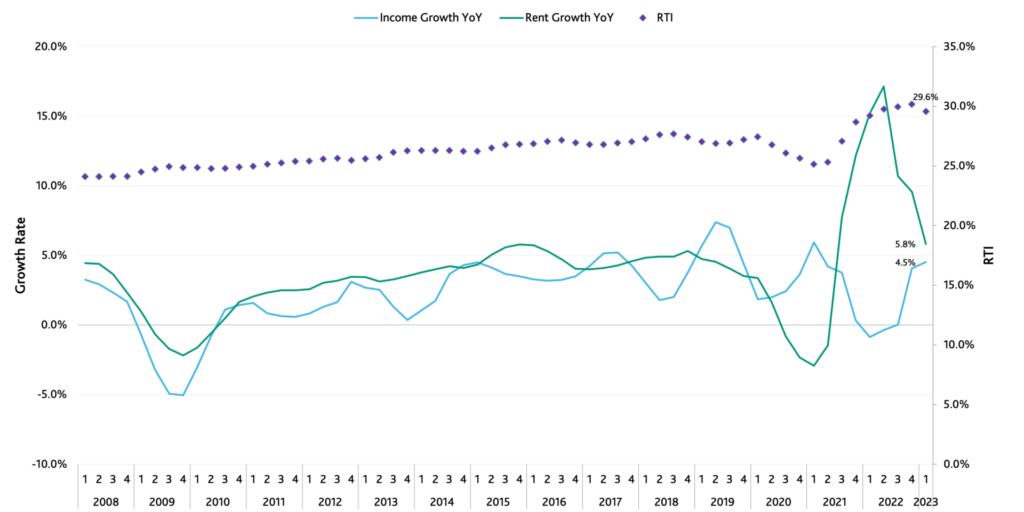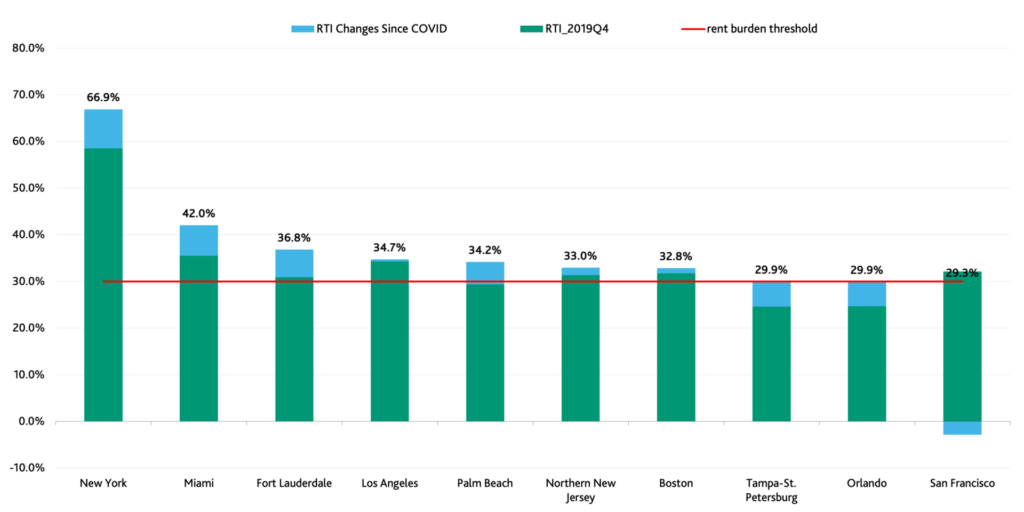Cost-of-living concerns are top of mind amongst Americans while rent-to-income ratios (RTI) remained elevated in Q1, according to Moody’s Analytics US State of Rent Burden report and data interactive tool.
While seasonal slowness and rising multifamily inventory moderated rent growth, the number of US primary metros still experiencing higher rent burdens plummeted from 49 metros down to only five, a 91% drop from Q4 2022 to Q1 2023. RTI – the percentage of gross income a median-income tenant pays for the average monthly rent – finally cooled after more than three years of steepening rates nationwide.
“The fever is finally breaking. Since Q4 2019, 82% of metros had higher rent-burdens compared to pre-COVID because rent disproportionately rose faster than incomes,” wrote Lu Chen, Senior Economist, and Mary Le, Economist, Moody’s Analytics. “Rising mortgage rates caused many households to be priced out from homebuying and would-be buyers to remain renters. Apartment demand surged as a result and drove rates sky high. The vast majority (91%) of all metros finally caught a break from growing rent burdens in Q1, as rent growth moderated or even declined given affordability pressures and slowing migration. However, we are not quite at an inflection point yet.”

New York City, Miami, Fort Lauderdale, Los Angeles, Palm Beach, Northern New Jersey, Boston, Tampa-St. Petersburg, Orlando, and San Francisco remained the top metros where median income households bear the heaviest rent burden across the nation. While the top seven have been considered “rent burdened” for quite some time, COVID’s upheaval of traditional migration patterns and changes to lifestyle landed Tampa-St. Petersburg and Orlando on the list as households chased the sun and moved to the Sunbelt in droves. On the other hand, San Francisco continued to be the only metro whose average market rent still lagged behind 2019 (-2.2%).
Even with this near-term relief, the cost of shelter remains significantly elevated relative to wages when compared to past decades. In 1999, just one metro was rent-burdened: New York City, with the median NYC household allocating 53.5% of their income to the average-priced apartment. Today, seven US metros fall within this designation: NYC (now 66.9% RTI), Miami (42%), Fort Lauderdale (36.8%), Los Angeles (34.7%), Palm Beach (34.2%), Northern New Jersey (33%), and Boston (32.8%).
The number of metros experiencing higher rent burdens plummeted 91% from a quarter ago, from 49 in Q4 2022 down to only five in Q1 2023. In Q1 of 2023, 91% (72 of 79) of metros finally had a break from growing rent burdens, 85% of which (61 of 72) was due to rent declines while the rest benefited from higher income growth. Fairfield County (-2.1%), New York City (-2.0%), Los Angeles (-1.1%), Las Vegas (-1.1%), and Greensboro/Winston-Salem (-1.0%) topped the list with more than 100 bps quarter-over-quarter decline in RTI, mainly attributed to lower rent in Q1.
Rent burden grew for only five primary metros this quarter, compared to 49 metros in Q4. Buffalo, Columbia, Tacoma, Charleston, and Norfolk/Hampton Roads experienced positive quarter-over-quarter RTI change ranging from 0.1% to 0.4%.

COVID-19 only exacerbated this issue. NYC’s RTI increased 8.4% between Q4 2019 and Q1 2023. Many metros followed suit, forcing several to become “rent-burdened”, meaning the typical household pays 30% or more of their income to rent. In Q4 2022, the US became “rent-burdened” nationwide for the first time in nearly 25 years of Moody’s Analytics tracking history.
“As wage growth trails behind the cost of shelter, Americans are feeling financially distressed,” continued Chen and Le. “With rent growth projected to hover around 2% annually, national RTI will stay mostly flat for the year (29.7%). That is still uncomfortably elevated and only trailing behind last year’s broken record.”
Elevated rent levels kept expensive metros’ rent-to-income ratio consistently around 30% in the past few years. As the Federal Reserve aggressively raised interest rates to curb inflation, expensive metros’ single-family housing market reacted to the mortgage rate changes quickly and led an accumulative 5.3% of value decline in Q1.
To read the full report, including more data, charts and methodology, click here.

 DSNews The homepage of the servicing industry
DSNews The homepage of the servicing industry









